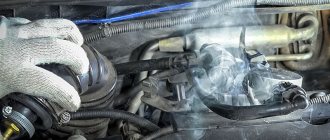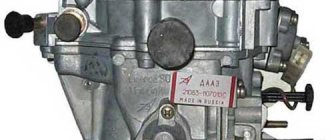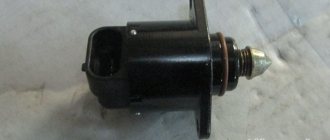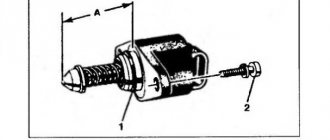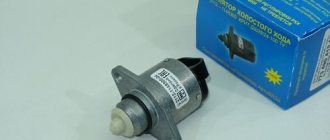Many motorists have experienced high engine speeds when idling. But not all car enthusiasts know why this happens, much less how to solve the problem without contacting a car service center. The article will help you analyze the issue in more detail, as well as find ways to solve the problem.
Idle speed: what is it?
In all devices of a mechanical or electrical operating principle, there is such a thing as idle speed. In simple words, idling is the absence of load, in this case on an internal combustion engine.
The correct operation of the internal combustion engine is shown, in many cases, by the behavior of the engine at idle, that is, vibration in idle mode and the noise of the engine (there are no noise jumps from louder to quieter). If these indicators are stable, this is considered normal engine operation at idle speed (idling speed).
Advice from an experienced
It is quite possible that the problem is in the throttle assembly itself. A jammed damper is a completely viable reason for an increase in engine speed. Usually the return spring is capricious: over time it stretches and can no longer ensure proper fit of the damper. However, the possibility of accumulation of contaminants cannot be ruled out. Based on the results of compiling material on cleaning the VAZ 2170 throttle assembly, we came to the conclusion that this procedure can sometimes cause floating idle speed.
The coolant temperature sensor deserves special attention. And not the one that sends a signal to the instrument cluster, but the one that interacts directly with the ECU. If the readings are incorrect, the warm-up nature of the engine will be observed immediately.
One last piece of advice. If the gas pedal is not electronic, open the hood and pull the throttle. Pay attention to how the cable moves inside the shirt to see if it gets stuck. You need to be extremely careful with lubricants in this area: the wrong composition will only aggravate the situation, especially in winter, when it thickens.
High engine speed at idle: injector.
The differences in the engine operating modes at idle speed and operation under load are that in the idle mode, the air into the combustion chamber is not directed through the throttle valve, that is, the throttle valve is closed.
For a large number of cars with internal combustion engines, normal fuel consumption at idle is considered to be 600-1000 rpm. However, such problems are observed in many cars - these are increased idle speeds on a warm engine, this is from 1500 rpm and more.
Particularly unpleasant-to-hear engine operation at idle is the floating operation of the engine. When the internal combustion engine “floats” at 20 rpm, it either jumps to 2000 rpm or drops to 700 rpm.
The appearance of a floating idle and consistently high speed on a hot engine arises due to the same reasons.
For injection engines, the reasons for high speeds and floating idle speeds are improper air supply and enrichment or leanness of the mixture. The speed depends on the air supplied to the cylinders. Wide open throttle forces a lot of air into the intake manifold. After which, the electronic control unit (ECU) determines how much air has been supplied, determines how much the throttle valve is open (at what angle), and also determines the necessary temperature parameters, and from here it decides how much gasoline should be supplied.
If the electronic control unit, due to a malfunction, is unable to determine how much air has passed through the throttle valve, the controller will raise the speed by enriching the mixture, that is, increasing the fuel supply. If more fuel is supplied and there is still additional air, which the ECU does not take into account, then the mixture becomes lean, which will cause unstable idling of the injector and may stall.
In simple words, the speed will decrease if the fuel mixture becomes lean. And, if the speed drops, then, accordingly, the injection power unit will begin to suck in less air.
When the ratio of fuel and air becomes optimal, the composition of the mixture becomes normal and the speed becomes high, then low again, the injector will “float”.
To eliminate the cause of floating operation of the internal combustion engine or persistently increased idle speed of the injector, you should check the sensors and the tightness of the system:
- TPDZ.
- DPRV.
- Air leak on the intake manifold.
It happens that the engine maintains stable, high, non-floating speeds from 1500 rpm to 2000 rpm. This operation is due to the fact that the injector supplies more fuel at idle, sufficient for stable speed. Due to such incorrect operation, there is excessive fuel consumption. If the engine has air flow meters and pressure sensors on the intake manifold, then this problem may not exist. The most common reason for increased speed or floating idle on both injection and carburetor engines is air leaks.
You need to look for the cause in the intake. It may suck due to:
- Throttle valve.
- Idle channel.
- A device for holding speed while the engine warms up.
- Servo drive for forced increase in idle speed.
The reason is the throttle valve
The gas pedal is responsible for opening and closing the throttle valve. Normal engine operation at idle is one in which there is no need to press on the gas to maintain idle speed. There are mechanical gas pedals, which open and close the valve using a cable, and electronic ones.
The mechanical accelerator may not work properly due to damage to the cable (fracture, overshoot, oxidation). When the cable is damaged, the electronic control unit (ECU) can receive a signal that the gas pedal is pressed and the injector provides increased speed.
The reason is in the idle channel
In this case, excess air passes through channel XX. Many fuel-injected engines have a special idle air passage that goes around the throttle valve. This design provides a screw for adjusting the cross-section of the air supply channel. Using this screw, opening or closing the channel, you can set the optimal idle speed.
The reason is a special additional device that maintains speed when the internal combustion engine warms up.
The engine design provides a separate channel for air supply, which should be closed automatically by a rod or damper after the motor reaches operating temperature. The device for stabilizing speed when the engine warms up has a temperature-sensitive element. Like the thermostat, this temperature-sensitive element works in tandem with the coolant. See what happens if you mix antifreeze and antifreeze.
When the injection engine is hot, the rod or valve completely blocks the channel. After closing the channel for supplying additional air, the ECU determines that the amount of air supplied has dropped and, accordingly, reduces the fuel supply.
When the injection engine is cold, the channel of this device is open, the electronic control unit receives data from the temperature sensor and enriches the fuel mixture.
In connection with this principle of operation, this means that if the idle speed increases or floats, the temperature sensor or this device, which provides speed support while the engine warms up, has failed.
More and more car enthusiasts are starting to make a manual tire changing machine with their own hands. It’s easy to make, you don’t need a lot of materials, and it will bring benefits every season.
The reason is the servo drive for forced increase in idle speed.
A servo drive (servo device) in an internal combustion engine is an idle speed regulator. The servo device is mounted in the air duct. The essence of this device is that it itself forcibly increases the idle speed. Depending on the design of the engine, the servo device can be: an electric motor, a solenoid, one of the options for the solenoid valve, etc.
Thanks to the servo drive (regulator), the process of transition from a state of operation under load to a quiet state, that is, when the gas pedal is released, is carried out smoothly. Even if you suddenly release the accelerator pedal, the speed will drop gradually.
Also, this regulator increases the speed when starting the injection engine, then smoothly reduces it.
If you put a load on the engine, this could be turning on the car air conditioner, heated seats, heated mirrors, turning on the headlights, then the servo device also raises the speed.
This device is responsible for the smooth operation of the engine. Therefore, if the servo drive breaks down, the engine starts to operate either at high speeds or “floats” at idle.
How to detect
Any driver can understand that the engine speed is higher than normal. To the ear, the sound and vibration of the engine at high speeds is much louder, and at idle the car becomes quiet. In addition, the car is equipped with a “tachometer”, by which you can understand the increased or decreased speed of your engine. Of course, each engine model has its own idle speed.
Therefore, I can only roughly suggest that the norm is considered to be from 650 to 550 idle speed on a warm engine; look for more details in the passport of your vehicle. When the RPM value exceeds normal values, this is considered a deviation for which the cause must be sought. In injection cars, a light on the dashboard lights up if the speed is increased, with the image of the engine “Check Engine”. Consequences
The first unpleasant consequence is, of course, an increase in fuel consumption. Because some of the fuel is simply released through the exhaust manifold. The service life of the motor is also not for the better. Because working with increased load wears out parts faster. The node itself, due to which this happens, can also become unusable.
That is why, when this problem appears, it must be eliminated immediately, and not wait until major troubles arise.
High engine speed at idle: carburetor.
A carburetor engine is simpler than an injection engine in terms of do-it-yourself repairs. There are different carburetors, but SOLEX is considered the best. You can adjust and configure the SOLEKS carburetor yourself. High idle speeds in such engines occur due to a malfunction in the metering device.
Reasons for increased speed in an engine with a carburetor:
- The idle speed is not set correctly. To adjust the idle speed, the carburetor has a special idle adjustment screw. Rotation of this screw either enriches or leans the fuel mixture.
- The air damper is not able to open all the way.
- Due to defects or incorrect adjustment of the actuator, the damper cannot close completely. This is the valve that is located in the first chamber of the carburetor.
- Accumulation of fuel in the carburetor chamber where the float is located. Exceeding the fuel level can cause an increase in speed and create jumps in idle speed.
Methods for solving the problem
Before proceeding directly to the process of solving the problem, you need to understand that diagnostics and repair of these components should be performed only with knowledge of the matter. Also, it is worth separately noting that for a carburetor and injection engine there will be different diagnostic methods, but the principle of the causes is the same.
So, it is worthwhile to consistently understand the diagnostic and repair work that will eliminate high idle speed.
IAC sensor
It is not often possible to find an idle air control sensor on carburetor engines. This is usually done using a quality and quantity screw. To normalize high idle speeds, you should not carry out the process cold. First, you should warm up the engine to operating temperature, and only then begin adjustments. If after making the adjustments the speed remains high, then the reason is different.
For an injection engine, the opposite is true; all adjustments are made by the IAC sensor. In order to correct the malfunction, it is worth checking the sensor with a multimeter, and then, if the element is faulty, replace it with a new one.
TPDZ
The wrong amount of air entering the combustion chamber can cause the ECU to over-idle. If the throttle position sensor is faulty, it must also be checked. This can be done with a multimeter or oscilloscope. If it is discovered that the TPS is faulty, it is worth replacing it.
We recommend: What function does the timing chain perform?
Motor temperature sensor
A failure of the temperature sensor can lead to many problems. One of these will be an increase in idle speed. Typically, as practice shows, this sensor is the most vulnerable and most often fails because it is exposed to temperature changes.
First, it’s worth diagnosing the health of the unit. This can be done using a multimeter and an oscilloscope. If the unit is faulty, it should be replaced. After this, it is recommended to reset all ECU errors.
Collector
Often, due to the use of the vehicle, the intake manifold becomes deformed or the gasket wears out. Thus, an increase in idle speed may indicate that there is an air leak in the manifold. To treat the malfunction, you will have to dismantle the part, which is quite problematic, since almost the entire injection system and several components of other systems are attached to the manifold.
It is worth examining the manifold gasket in detail; the presence of damage may indicate not only problems with speed, but also other malfunctions. Also, deformation of the cavity can cause excess air to enter the combustion chambers. This can affect warming up, engine starting and other factors.
To fix the problem, you will have to grind the surface of the collector until it is smooth. In car services, this is done using a special machine. Of course, you can carry out the process in a garage, using a special stone, but this is not always possible for car owners.
Electronic control unit
Repeatedly high idle speed is a consequence of incorrect operation of the electronic control unit. So, to troubleshoot a problem, you will have to connect to the “brains” and fix the problem at the software level. To complete the process you will need a special cable and software.
But simply resetting errors does not always help; you often have to change the software in order for all the problems to finally go away. It is recommended to trust this process to masters who are professionals in their field.
Along with replacing the firmware, you can increase the power characteristics, which is also recommended to be entrusted to specialists. As practice shows, most car enthusiasts, when independently tampering with the ECU, end up in a car service center to eliminate the consequences of their own modifications.
Electronics failures
Idle speed control
Checking the engine idle speed control
After replacing the idle air regulator, it must be “registered” i.e. enter its parameters into the ECU memory.
The idle air control (IAC) is a stepper motor (solenoid) that operates from pulse signals supplied by the electronic control unit (ECU) . It works in a similar way to the screw for adjusting the amount of mixture in the carburetor - when the valve extends, it closes the fuel channel, and when it moves back, it opens it. It often happens that the regulator core simply jams and it stops responding to ECU signals. Moreover, you can damage the idle air regulator even in the store when purchasing it - by trying to turn or press the valve needle with your hands. If after replacing the idle speed sensor (regulator) there are high speeds, then most likely the problem is either in the ECU or in the mass air flow sensor - all the elements that make up the power system work in interaction, and diagnostics need to be carried out. It is quite possible that you will have to “register” a new regulator - that is, enter its parameters into the ECU memory.
temperature sensor
This sensor can also affect the engine fuel system. By issuing an incorrect signal (corresponding to a low temperature) to the ECU, it will cause the controller to give a signal to other elements of the fuel system (including injectors) that the mixture is enriched. An incorrect sensor signal will result in idle speeds exceeding 1000 min-1.
Mass air flow sensor
The mass air flow sensor directly affects the quality and quantity of the mixture supplied to the cylinders - after all, the ECU “knows” about its composition thanks to this (and some other) sensors. In conclusion, if your car’s engine has increased idle speed for no reason, first look for the cause in possible jamming of the fuel system mechanisms - after all, they are the ones who are primarily exposed to various contaminants, and for electronic components, power surges or short circuits are much more dangerous.
We recommend: How to remove an air lock from the cooling system
Air flow meter failure
The air flow meter is responsible for the correct preparation of the fuel-air mixture, which directly affects the crankshaft speed. To determine such breakdowns, computer diagnostics are performed or special measuring instruments are used.



